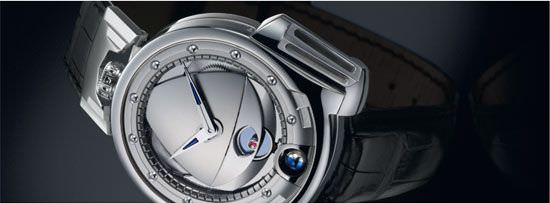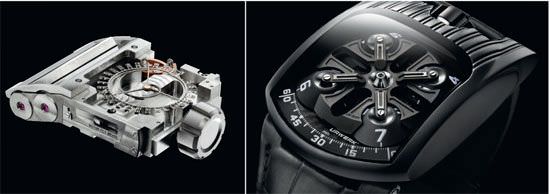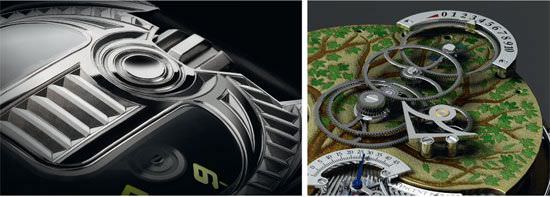The organizers of the Salon International de la Haute Horlogerie did not initially want it that way, but the great attraction of their event transformed Geneva into a veritable capital of Haute Horlogerie for an entire week in mid-January. Nearly fifty brands decided to organize their own exhibitions during the dates of the SIHH, with most taking place in a handful of luxury hotels along the lakeshore in Geneva.
Good idea, since it seems that a large number of visitors took the time to visit these small shows. These same visitors—agents, distributors, and journalists—who normally would arrive in Geneva after an exhausting week in Basel, clearly came with a more open mind and the desire to see the creativity and fresh approaches offered by independent watchmakers—qualities that are often lacking with brands that are subject to the stringent demands of their shareholders.
The shrewdest of them all, Franck Muller, organized the first WPHH of the year in the brand’s Watchland headquarters. It was the first because the group of Vartan Sirmakes decided to organize three events this year: one in parallel with the SIHH; one after BaselWorld; and one in August, which will be devoted specially to the brand’s Mid-Eastern clientele who like to spend a part of their summer in Geneva.

CALIBRE FM 3210 by Pierre-Michel Golay
MEGA by Franck Müller
While it would be impossible to talk about all of these independent events, we will however take a brief look at a few particularly inventive and creative brands, as well as the presentation by Franck Muller of its “first homemade” automatic chronograph movement.
Pierre-Michel Golay, master watchmaker in the “old style”
Since 2002, Pierre-Michel Golay has been responsible for R & D at Franck Muller. The man obviously has a lot of experience under his belt. Originally from the Vallée de Joux, he has complicated timekeeping in his blood, and we owe him the very famous Grande Sonnerie with Perpetual Calendar created in 1996 for Gérald Genta, with whom he had already been working since 1973. After a stint at the Geneva Watchmaking School (where he was responsible for the Poinçon de Genève), Golay was hired by Franck Muller to work on a minute repeater, one of his specialties.

GRANDE SONNERIE WITH PERPETUAL CALENDAR by Pierre-Michel Golay
The infamous “war of the chiefs” that tore the Franck Muller group apart in 2003 caused a number of the brand’s watchmakers to leave, forcing Golay day to start afresh. In 2005, Didier Decker, then executive director of the group (and now with Harry Winston) asked Golay to design a watch “with the maximum number of hands.” This was the beginning of the adventure of the Aeternitas, and then the Mega, a truly spectacular piece featuring an automatic movement, Westminster carillon, minute repeater, and a power reserve of 100 hours.
Pierre-Michel Golay then accepted another challenge: design from scratch the first Franck Müller automatic chronograph movement. Four years were necessary to develop this calibre, conceived from the very beginning with its industrialization in mind. Everything—or nearly everything—was done within the group, which demonstrates the brand’s progressive verticalization efforts with a view to its autonomy. Brass and steel items were made in a unit owned by the group in Meyrin, near Geneva; cutting and milling were done at Watchland; dials came from Linder, a company in the Jura, also a part of the group.
The escapement (21,600 vib/hour) with its steel escape wheel produced with the Mimotec process, was designed in-house, while the balance, collet, and balance-spring stud came from outside (Schaffhausen). Very compact and well structured, this automatic movement, the Calibre FM 3210, intentionally called Freedom, with a wink, is equipped with a traditional column wheel and vertical coupling with flyback function.
Its original winding system of “bielle-manivelle” (crank and rod) is visible between the bridges and the plate. The movement has also been finished in a lovely artisanal style (Côtes de Genève, circular-graining, chamfering, rhodium-plated). In addition, it features a semi-instantaneous display of the date and a small seconds hand at 9 o’clock. Once it is made totally reliable, it will take its place in the concert of automatic chronograph movements.
In parallel, Pierre-Michel Golay is launching, within the group, his own brand, which carries his name. A lover of the most traditional timekeeping (he is more than 70 years old), Golay will propose a dozen or so different movements this year. Most will be tourbillons, designed on a base that he himself calls a “tractor”—a calibre with a power reserve of eight days, small seconds hand, and Côtes de Genève finishing.
The architecture of his movements—of which we were able to see some prototypes—is superbly classical in nature, with, notably, the rare detail of the gold jewel settings in relief. Other features include the complete date in a window, a mysterious tourbillon, perpetual calendar, minute repeater, and flyback chronograph with the hour counter in a window. Never have we seen a “new” brand launch with such a great number of high flying watches. Well, it certainly took someone like Golay to pull it off, or rather two Golays since Pierre-Michel is assisted by his cousin, Jean-Pierre Golay.
Let’s hope that the Franck Müller group will be able to provide, which alas has not always been the case for all the brands under its umbrella, this new brand with the excellent distribution network that it deserves a hundred times over. The offer signed Pierre-Michel Golay is truly complementary to that of the other brands in the group, crowning it with its classicism without compromise.
De Bethune, an exceptional laboratory
Another “hard and fast” watchmaker, who is in his own way respectful of the canons of historical timekeeping while being fiercely innovative, is Denis Flageollet, founder of De Bethune along with David Zanetta.
In Flageollet’s mind, chronometry is an essential part of timekeeping. It is what inspired the “Ancients”. Yet, in his quest for perfect chronometry, he is following a more contemporary path, illustrated, for example, by the DBW1, inspired by his recent Dream Watch One.

DBW1 by De Bethune
“Between the workbench on which we can perfectly adjust a movement from 0 to +6 seconds, then put it into its case, and then wear it, there is necessarily a certain amount of variation that will occur. This can be as much as -10 to +30 seconds. But if well adjusted, a watch will always maintain its regularity. Variations in time occur as a function of the wearer, that is, they will depend on his level of activity and whether he is often outdoors or not, and they will occur according to a variable average. We can affect this variation and the wearer is in the best position to do so. I therefore designed a system of adjusting the seconds. By a simple push on one of the two pushbuttons, either + or -, on the back of the watch, its owner can adjust it as a function of his lifestyle thanks to a system of gear-down arms and levers.”
This attention to the pure functionality of the watch—but also to its comfort, readability, and ease of use—is also found in the thought process behind his DB Tourbillon. In this case, Flageollet adapted, to a wristwatch, his tourbillon made entirely of silicon and titanium, without a carriage or pillar, with its silicon balance and thermo-compensating plate. The frequency of this manual-winding calibre is 36,000 vibrations per hour, a frequency that is truly high-performing since the silicon does not require lubrication. As we know, lubricating a traditional calibre that oscillates at 36,000 vibrations per hour involves a number of problematic issues.
With this type of innovation, De Bethune is positioning itself as one of the true labora-tories in the realm of haute horlogerie. On top of this, the design of its pieces, largely inspired by David Zanetta, is totally modernistic while never compromising on readability or ergonomics.
Interestingly, David Zanetta is also thumbed his nose at the large brands by creating his own automobile, an incredible prototype that was showcased during the exhibition. “The grand watchmakers are all fighting to place the name of a famous car brand on their dials. As for me, I did just the opposite. I created my own car from my own parts,” says Zanetta—a car that will undoubtedly become famous in its own right.
Tarantulas and other mechanical animals
Another style but with the same thirst for innovation is exemplified by Urwerk. This year, Félix Baumgartner, the watchmaker, and Martin Frei, the designer, and their team of eight people presented a special edition of the famous UR103—the UR103T, with the “T” standing for “Tarantula.”
The central cross of the classic UR103 has been replaced by a structure in the metal alloy ARCAP that, like a tarantula, wraps around the four hour satellites. Only the satellite displaying the exact time, the premium, travels along the arc of the minutes. During this time, the three other satellites each make four turns of 120° on their own axis. This unusual display undoubtedly requires an exceptional precision during machining.
To add an exotic touch to the exhibition, the watch, as black as the spider itself, was presented in a vivarium where it was placed alongside a real live tarantula.

CC1 prototype by Urwerk
UR103T by Urwerk
Nearby, we also were able to see the prototype of another creation by Urwerk, the CC1. In its double C title, one C stands for the codename Cobra (we look forward to seeing the vivarium next year!) and the other C pays homage to Louis Cottier—a Geneva watchmaker best known for the universal time watch created for Patek Philippe, as well as a patent filed in 1959 for a watch with a linear display. Although Cottier’s linear display timepiece was never made, Baumgartner and Frei found this principle intriguing and decided to create a piece along these lines. They intend to present the CC1 in the near future. We invite you to have a look at the photo and try to guess how this “cobra” mechanism works.
Finally, Urwerk presented an artistic piece in collaboration with the engraver, Jean-Vincent Hugenin. This artist, who loves the solitude of his atelier along the shore of Lake Neuchâtel, uses his powerful burin to demonstrate how engraving can be a perfect ally to the most vibrantly modernist piece. He composes vigorous lines, cutting deep grooves resembling Art Déco styling, which glorify Urwerk’s timekeepers even more by adding an original poetic vibe.

UR103 ArtDeco engrived by Jean-Vincent Hugenin
Four Season Spring Back by Vincent Bérard
Real content, not just a container
Another form of poetry, this time softer and lighter, is that displayed by Vincent Bérard. Slowly, at his own pace, Bérard has developed a rather particular type of watchmaking by taking time for reflection in order to “work in-depth” not only on the functioning of his very beautiful movements with their tiered bridges, but also on their decoration, while building the reputation of his brand in a step-by-step manner.
Supported by the Timex group—which surprised everyone—Bérard is, along with Herbert Gautschi, now in charge of twenty or so watchmakers and artisans, who all work in a beautiful renovated farm near La Chaux-de-Fonds. “Our business plan is based on the next fifteen years,” explains Gautschi. “The first pieces were delivered in October 2008, and I personally took them to our clients in Asia, Japan, India, the USA, and Switzerland. Up to now, the watches number only a few dozen, but we intend to make around a hundred per year.”
A hundred yes, but the attention to detail is amazing, not only for the watches but also for their environment. Vincent Bérard designs everything, from the watches to their packaging, presentation boxes, displays, tables, and furniture. He takes a truly artistic approach that is far from the well-trodden paths—an approach that is both modest (“Don’t forget that timekeeping is 500 years old,” he likes to say) and yet terribly ambitious.
Let’s hope that time—and our chaotic time—will do justice to his wonderful watches. “Because”, as he muses, “it is high time to redefine luxury, to return to certain values, and to again find the veritable culture that creates true luxury. There must be real content, not just a container.”
The generosity of Antoine Preziuso
The week, which began in the luxurious corridors of the large groups worried about orders and balance sheets, ended in the company of poets. And among them is Antoine Preziuso, a person who never stopped dreaming of his watches. A poet and also a couturier in his own way, he creates for his own movements (ETA 2892 calibres that he reworks from top to bottom, which he prefers over all others because of their reliability under all circumstances, their robustness, and their precision) outfits that he varies according to his moods, alternately sparkling or sombre, made of meteorite or titanium.
His latest creation, Metropolis, is a square watch, carved in titanium and then polished, which was greatly inspired by the Asian cities that he visits. Entirely made in the brand’s Geneva ateliers, the Metropolis features very geometric hands, a dial flanked by “metallic buildings”, detachable and removable horns, and an off-centred movement, thus giving it a remarkable presence.

METROPOLIS by Antoine Preziuso
Antoine Preziuso is also a generous poet, and thinks of others. As one example, he helped students at Geneva’s Centre de Formation en Arts Appliqués, by offering them nine cases, requesting that the students transform them as they see fit. The result is nine outstanding ideas that demonstrate to all those moaners that there are still a thousand things to do in timekeeping, and that its history is far from over.



Nine outstanding ideas
1. . DE VUE by Laura Infante
2.ASHURA by Justine Parnigoni
3.HIDDEN FACE OF TIME by Tiffany Baehler
4.LA ROUE DU TEMPS by Ivanoé Miller
5.DESTROY TIME by Mickaël Melcher
6.DAY & NIGHT by Su Mo
7.ELARA by Valérie Ebiner
8.END LESS by Edir Cide Costa
9.DAT-TIME by Maxime Centeno
Source: Europa Star February-March 2009 Magazine Issue





